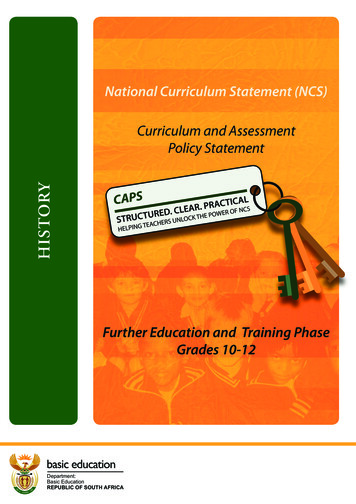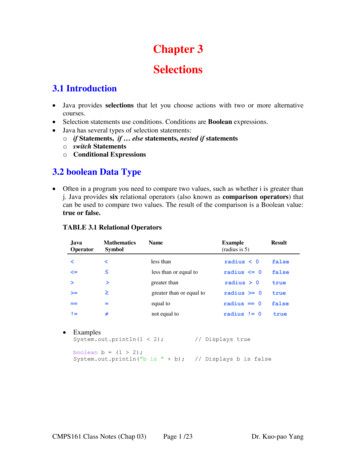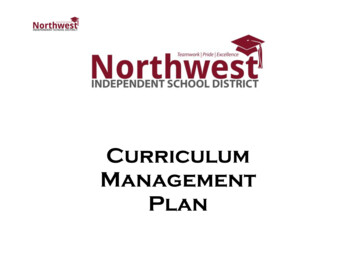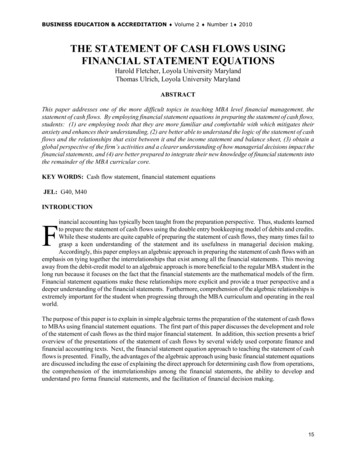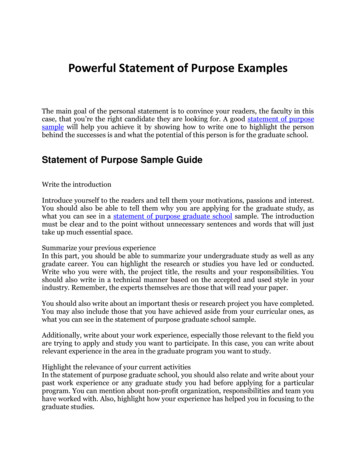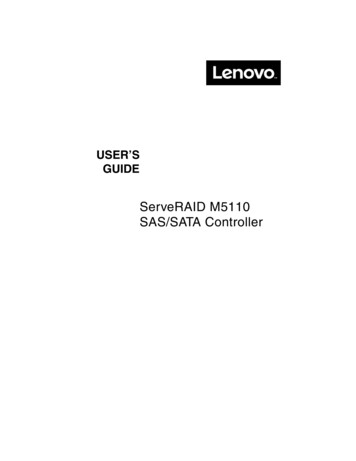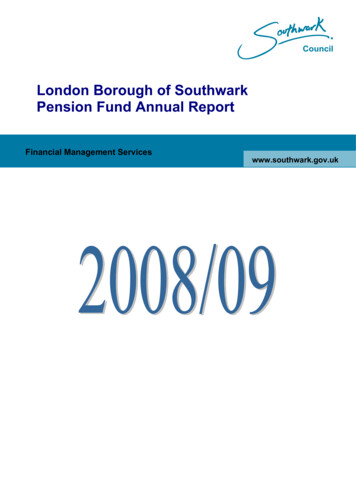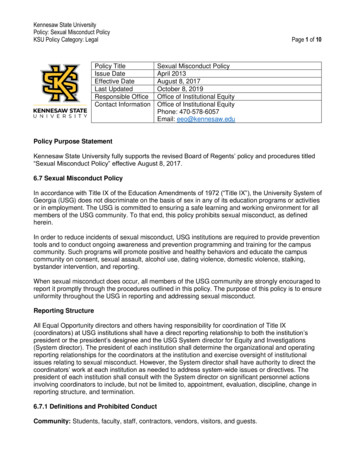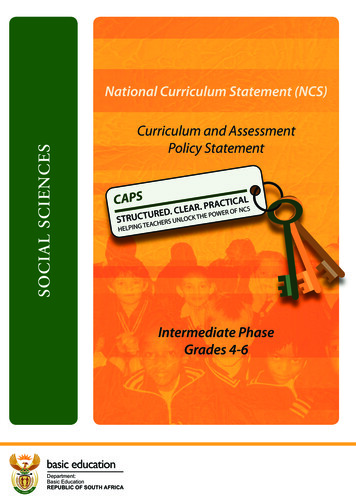
Transcription
SOCIAL SCIENCESNational Curriculum Statement (NCS)Curriculum and AssessmentPolicy StatementIntermediate PhaseGrades 4-6
CURRICULUM AND ASSESSMENT POLICY STATEMENTGRADES 4-6SOCIAL SCIENCESCAPS
SOCIAL SCIENCES GRADES 4-6DISCLAIMERIn view of the stringent time requirements encountered by the Department of Basic Education to effect the necessary editorial changes and layoutto the Curriculum and Assessment Policy Statements and the supplementary policy documents, possible errors may occur in the said documentsplaced on the official departmental websites.There may also be vernacular inconsistencies in the language documents at Home-, First and Second Additional Language levels which have beentranslated in the various African Languages. Please note that the content of the documents translated and versioned in the African Languages arecorrect as they are based on the English generic language documents at all three language levels to be implemented in all four school phases.If any editorial, layout or vernacular inconsistencies are detected, the user is kindly requested to bring this to the attention of the Department ofBasic Education.E-mail: capslangcomments@dbe.gov.za or fax (012) 328 9828Department of Basic Education222 Struben StreetPrivate Bag X895Pretoria 0001South AfricaTel: 27 12 357 3000Fax: 27 12 323 0601120 Plein Street Private Bag X9023Cape Town 8000South AfricaTel: 27 21 465 1701Fax: 27 21 461 8110Website: http://www.education.gov.za 2011 Department of Basic EducationISBN: 978-1-4315-0489-3Design and Layout by: Ndabase Printing SolutionPrinted by: Government Printing Works2CURRICULUM AND ASSESSMENT POLICY STATEMENT (CAPS)
SOCIAL SCIENCES GRADES 4-6FOREWORD BY THE MINISTEROur national curriculum is the culmination of our efforts over a period of seventeenyears to transform the curriculum bequeathed to us by apartheid. From the start ofdemocracy we have built our curriculum on the values that inspired our Constitution(Act 108 of 1996). The Preamble to the Constitution states that the aims of theConstitution are to: heal the divisions of the past and establish a society based on democraticvalues, social justice and fundamental human rights; improve the quality of life of all citizens and free the potential of each person; lay the foundations for a democratic and open society in which government isbased on the will of the people and every citizen is equally protected by law;andbuild a united and democratic South Africa able to take its rightful place as a sovereign state in the family ofnations.Education and the curriculum have an important role to play in realising these aims.In 1997 we introduced outcomes-based education to overcome the curricular divisions of the past, but the experienceof implementation prompted a review in 2000. This led to the first curriculum revision: the Revised National CurriculumStatement Grades R-9 and the National Curriculum Statement Grades 10-12 (2002).Ongoing implementation challenges resulted in another review in 2009 and we revised the Revised NationalCurriculum Statement (2002) and the National Curriculum Statement Grades 10-12 to produce this document.From 2012 the two National Curriculum Statements, for Grades R-9 and Grades 10-12 respectively, are combinedin a single document and will simply be known as the National Curriculum Statement Grades R-12. The NationalCurriculum Statement for Grades R-12 builds on the previous curriculum but also updates it and aims to provideclearer specification of what is to be taught and learnt on a term-by-term basis.The National Curriculum Statement Grades R-12 represents a policy statement for learning and teaching in SouthAfrican schools and comprises of the following:(a)Curriculum and Assessment Policy Statements (CAPS) for all approved subjects listed in this document;(b)National policy pertaining to the programme and promotion requirements of the National Curriculum StatementGrades R-12; and(c)National Protocol for Assessment Grades R-12.MRS ANGIE MOTSHEKGA, MPMINISTER OF BASIC EDUCATIONCAPS
SOCIAL SCIENCES GRADES 4-6CURRICULUM AND ASSESSMENT POLICY STATEMENT (CAPS)
SOCIAL SCIENCES GRADES 4-6CONTENTSSECTION 1: INTRODUCTION TO THE CURRICULUM AND ASSESSMENT POLICY STATEMENT. 31.1Background. 31.2Overview. 31.3General aims of the South African Curriculum. 41.4Time Allocation. 61.4.1 Foundation Phase. 61.4.2 Intermediate Phase. 71.4.3 Senior Phase. 7SECTION 2: INTRODUCTION TO SOCIAL SCIENCES. 82.1What is Social Sciences?. 82.2Resources. 82.3Additional Resources. 92.4History. 102.4.1 What is History?. 102.4.2 Specific aims of History. 102.4.3 Skills and concepts of History. 102.4.4 Concepts in History. 122.5Geography. 122.5.1 What is Geography?. 122.5.2 A note on developing mapping skills and using maps across the Geography curriculum. 132.5.3 Specific aims of Geography CAPS for Intermediate and Senior Phases. 132.6Projects. 142.6.1 Projects in Geography. 152.6.2 Projects in History: Suggested topics. 152.7Time allocations and weighting of topics. 162.8Overview of topics. 17SECTION 3: CONTENT OUTLINE AND ANNUAL TEACHING PLANS. 213.1Intermediate phase Geography: Outline of what is to be taught. 213.2Intermediate phase History: Outline of what is to be taught. 33CAPS1
SOCIAL SCIENCES GRADES 4-6SECTION 4: ASSESSMENT IN SOCIAL SCIENCES. 464.1Introduction. 464.2Informal or Daily Assessment. 464.3Formal Assessment. 474.3.1 Formal assessment requirements of Social Science. 474.3.2 Types of formal assessment for Social Science. 474.4Programme of Assessment. 514.5Recording and Reporting. 524.6Moderation of Assessment. 534.7General. 532CURRICULUM AND ASSESSMENT POLICY STATEMENT (CAPS)
SOCIAL SCIENCES GRADES 4-6SECTION 1: INTRODUCTION TOASSESSMENT POLICY STATEMENT1.1THECURRICULUMANDBackgroundThe National Curriculum Statement Grades R-12 (NCS) stipulates policy on curriculum and assessment in theschooling sector.To improve implementation, the National Curriculum Statement was amended, with the amendments coming intoeffect in January 2012. A single comprehensive Curriculum and Assessment Policy document was developed foreach subject to replace Subject Statements, Learning Programme Guidelines and Subject Assessment Guidelinesin Grades R-12.1.2Overview(a)The National Curriculum Statement Grades R-12 (January 2012) represents a policy statement for learningand teaching in South African schools and comprises the following:(i)Curriculum and Assessment Policy Statements for each approved school subject;(ii)The policy document, National policy pertaining to the programme and promotion requirements of theNational Curriculum Statement Grades R-12; and(iii)(b)The policy document, National Protocol for Assessment Grades R-12 (January 2012).The National Curriculum Statement Grades R-12 (January 2012) replaces the two current national curriculastatements, namely the(i)Revised National Curriculum Statement Grades R-9, Government Gazette No. 23406 of 31 May 2002,and(ii)National Curriculum Statement Grades 10-12 Government Gazettes, No. 25545 of 6 October 2003 andNo. 27594 of 17 May 2005.(c)The national curriculum statements contemplated in subparagraphs b(i) and (ii) comprise the following policydocuments which will be incrementally repealed by the National Curriculum Statement Grades R-12 (January2012) during the period 2012-2014:(i)The Learning Area/Subject Statements, Learning Programme Guidelines and Subject AssessmentGuidelines for Grades R-9 and Grades 10-12;(ii)The policy document, National Policy on assessment and qualifications for schools in the GeneralEducation and Training Band, promulgated in Government Notice No. 124 in Government Gazette No.29626 of 12 February 2007;(iii)The policy document, the National Senior Certificate: A qualification at Level 4 on the NationalQualifications Framework (NQF), promulgated in Government Gazette No.27819 of 20 July 2005;CAPS3
SOCIAL SCIENCES GRADES 4-6(iv)The policy document, An addendum to the policy document, the National Senior Certificate: Aqualification at Level 4 on the National Qualifications Framework (NQF), regarding learners with specialneeds, published in Government Gazette, No.29466 of 11 December 2006, is incorporated in the policydocument, National policy pertaining to the programme and promotion requirements of the NationalCurriculum Statement Grades R-12; and(v)The policy document, An addendum to the policy document, the National Senior Certificate: Aqualification at Level 4 on the National Qualifications Framework (NQF), regarding the National Protocolfor Assessment (Grades R-12), promulgated in Government Notice No.1267 in Government GazetteNo. 29467 of 11 December 2006.(d)The policy document, National policy pertaining to the programme and promotion requirements of theNational Curriculum Statement Grades R-12, and the sections on the Curriculum and Assessment Policy ascontemplated in Chapters 2, 3 and 4 of this document constitute the norms and standards of the NationalCurriculum Statement Grades R-12. It will therefore, in terms of section 6A of the South African Schools Act,1996 (Act No. 84 of 1996,) form the basis for the Minister of Basic Education to determine minimum outcomesand standards, as well as the processes and procedures for the assessment of learner achievement to beapplicable to public and independent schools.1.3General aims of the South African Curriculum(a)The National Curriculum Statement Grades R-12 gives expression to the knowledge, skills and values worthlearning in South African schools. This curriculum aims to ensure that children acquire and apply knowledgeand skills in ways that are meaningful to their own lives. In this regard, the curriculum promotes knowledge inlocal contexts, while being sensitive to global imperatives.(b)The National Curriculum Statement Grades R-12 serves the purposes of: equipping learners, irrespective of their socio-economic background, race, gender, physical ability orintellectual ability, with the knowledge, skills and values necessary for self-fulfilment, and meaningfulparticipation in society as citizens of a free country;(c) providing access to higher education; facilitating the transition of learners from education institutions to the workplace; and providing employers with a sufficient profile of a learner’s competences.The National Curriculum Statement Grades R-12 is based on the following principles: Social transformation: ensuring that the educational imbalances of the past are redressed, and that equaleducational opportunities are provided for all sections of the population; Active and critical learning: encouraging an active and critical approach to learning, rather than rote anduncritical learning of given truths; High knowledge and high skills: the minimum standards of knowledge and skills to be achieved at eachgrade are specified and set high, achievable standards in all subjects; 4Progression: content and context of each grade shows progression from simple to complex;CURRICULUM AND ASSESSMENT POLICY STATEMENT (CAPS)
SOCIAL SCIENCES GRADES 4-6 Human rights, inclusivity, environmental and social justice: infusing the principles and practices of social andenvironmental justice and human rights as defined in the Constitution of the Republic of South Africa. TheNational Curriculum Statement Grades R-12 is sensitive to issues of diversity such as poverty, inequality,race, gender, language, age, disability and other factors; Valuing indigenous knowledge systems: acknowledging the rich history and heritage of this country asimportant contributors to nurturing the values contained in the Constitution; and Credibility, quality and efficiency: providing an education that is comparable in quality, breadth and depth tothose of other countries.(d)The National Curriculum Statement Grades R-12 aims to produce learners that are able to: identify and solve problems and make decisions using critical and creative thinking; work effectively as individuals and with others as members of a team; organise and manage themselves and their activities responsibly and effectively; collect, analyse, organise and critically evaluate information; communicate effectively using visual, symbolic and/or language skills in various modes; use science and technology effectively and critically showing responsibility towards the environment andthe health of others; and demonstrate an understanding of the world as a set of related systems by recognising that problem solvingcontexts do not exist in isolation.(e)Inclusivity should become a central part of the organisation, planning and teaching at each school. This canonly happen if all teachers have a sound understanding of how to recognise and address barriers to learning,and how to plan for diversity.The key to managing inclusivity is ensuring that barriers are identified and addressed by all the relevant supportstructures within the school community, including teachers, District-Based Support Teams, Institutional-LevelSupport Teams, parents and Special Schools as Resource Centres. To address barriers in the classroom,teachers should use various curriculum differentiation strategies such as those included in the Department ofBasic Education’s Guidelines for Inclusive Teaching and Learning (2010).CAPS5
SOCIAL SCIENCES GRADES 4-61.4Time Allocation1.4.1 Foundation Phase(a)The instructional time in the Foundation Phase is as follows:SUBJECTHome LanguageGRADE R(HOURS)GRADES 1-2(HOURS)GRADE 3(HOURS)108/78/72/33/4First Additional LanguageMathematics777Life 5 Beginning Knowledge Creative Arts Physical Education Personal and Social Well-beingTOTAL(b)Instructional time for Grades R, 1 and 2 is 23 hours and for Grade 3 is 25 hours.(c)Ten hours are allocated for languages in Grades R-2 and 11 hours in Grade 3. A maximum of 8 hours and aminimum of 7 hours are allocated for Home Language and a minimum of 2 hours and a maximum of 3 hours forAdditional Language in Grades 1-2. In Grade 3 a maximum of 8 hours and a minimum of 7 hours are allocatedfor Home Language and a minimum of 3 hours and a maximum of 4 hours for First Additional Language.(d)In Life Skills Beginning Knowledge is allocated 1 hour in Grades R – 2 and 2 hours as indicated by the hoursin brackets for Grade 3.1.4.2 Intermediate Phase(a)The instructional time in the Intermediate Phase is as follows:SUBJECTHOURSHome Language6First Additional Language5Mathematics6Natural Sciences and Technology3,5Social Sciences3Life Skills4 Creative Arts Physical Education Personal and Social Well-beingTOTAL6(1,5)(1)(1,5)27,5CURRICULUM AND ASSESSMENT POLICY STATEMENT (CAPS)
SOCIAL SCIENCES GRADES 4-61.4.3 Senior Phase(a)The instructional time in the Senior Phase is as follows:SUBJECTHOURSHome Language5First Additional Language4Mathematics4,5Natural Sciences3Social Sciences3Technology2Economic Management Sciences2Life Orientation2Creative Arts2TOTAL27,51.4.4 Grades 10-12(a)The instructional time in Grades 10-12 is as follows:SUBJECTTIME ALLOCATION PER WEEK (HOURS)Home Language4.5First Additional Language4.5Mathematics4.5Life Orientation minimum of any three subjects selected from Group BAAnnexure B, Tables B1-B8 of the policy document, National policypertaining to the programme and promotion requirements ofthe National Curriculum Statement Grades R-12, subject to theprovisos stipulated in paragraph 28 of the said policy document.TOTAL212 (3x4h)27,5The allocated time per week may be utilised only for the minimum required NCS subjects as specified above,and may not be used for any additional subjects added to the list of minimum subjects. Should a learner wishto offer additional subjects, additional time must be allocated for the offering of these subjects.CAPS7
SOCIAL SCIENCES GRADES 4-6SECTION 2: INTRODUCTION TO SOCIAL SCIENCES2.1WHAT IS SOCIAL SCIENCES?The subject Social Sciences consists of History and Geography. Both History and Geography should be taught andassessed during every term of the school year. Although the two disciplines are kept separate, this curriculum isdesigned to complement the knowledge (content, skills and concepts) outlined in each.Assessment marks for each subject should be shown separately on school reports – a score for History and anotherfor Geography. They should then be added together and divided by two to give an average score for Social Sciences.This Social Sciences curriculum aims to provide opportunities for learners to look at their own worlds with fresh,critical eyes and perhaps more importantly, it aims to introduce learners to a world beyond their everyday realities.Schools should be special places that provide learners with knowledge to which they would otherwise not haveaccess.The importance of depth of knowledge is recognised. Real knowledge demands that learners develop expertise andconfidence as a result of in-depth learning. The topics in this curriculum specify pace through hours allocated. Timesindicate the depth required.Learners are trained to speculate, to debate, to make connections, to select, to prioritise and to persist, in tacklingreal issues and important questions.It is essential in the teaching of both History and Geography that learners are encouraged to ask questions: Who?Where? What? Why? When? How? Should? Could? Is/Are? And, by the time they reach the Senior Phase: If?The questions learners ask give teachers a good indication of prior knowledge, perceptions, interests, insights andconcerns.Language is an important element of both History and Geography. Different forms of text (oral, written and visual) arecentral to both disciplines. Learning takes place through interaction with these texts. It is important to remember thatevery teacher is a language teacher.Similarly, writing is a skill that is developed through these two subjects. Learners should write regularly, with aclear progression in length and complexity through the grades. The CAPS language documents specify levels ofrequirement for writing and should be consulted throughout. Evidence of learner’s work, including assessments,should be kept in the learner’s notebook.2.2RESOURCES Each learner should have a quality textbook and a neatly kept notebook. Textbooks must be suitable forthe grade, context and language level of the learner. They should provide accurate content that is aimedat the development of the appropriate skills, concepts and values. Textbooks must include appropriate andadequate assessment activities. It should be noted that the order in which the content in the sub-topics islisted is a guideline only. LTSM writers need not cover these sub-topics in the exact order in which theyappear in this document. Every Social Sciences classroom should have wall maps, a globe, access to a set of atlases and adictionary, as well as access to a variety of reading books and visual material suitable for the grade.8CURRICULUM AND ASSESSMENT POLICY STATEMENT (CAPS)
SOCIAL SCIENCES GRADES 4-6 Every teacher of Social Sciences should be familiar with the content to be taught, read widely on the contentof the topics for the term and prepare lessons carefully.2.3ADDITIONAL RESOURCESIt is important to bring the world into the Social Sciences classroom. Visual resources can make information moreaccessible to many learners. Teachers should therefore: have magazines and newspapers available in the classroom for learners to use in their activities and acquiresets of pictures for classroom activities; try to obtain access to a TV/DVD and/or CD player to present appropriate audio and audio-visual material tolearners; and try to use the Internet wherever possible. Many organisations and projects provide useful information throughthe Internet. Google Earth, for example, provides extensive aerial photographs. You-tube provides videos ofmany historical events.Maps for map skills: It is important that learners work with maps of their own local area. The MapPack Project is partof the Department of Rural Development and Land Reform. It provides five free maps to every school on request.These include local maps – 1:10 000 orthophoto map (if available) and 1:50 000 topographic map, and then ‘zoomout’ to a 1:250 000 map (covering two-degree squares which include the local area), a provincial map (scale varies)and a national map (1:2 000 000).Additional information, maps and aerial photographs are also available on request.Contact: The MapPack Project, Private Bag X10, Mowbray, 7700. Fax: 021 689 1351.Phone: 021 658 4300. Email: ngi@ruraldevelopment.gov.za. Web: www.ngi.gov.zaCAPS9
SOCIAL SCIENCES GRADES 4-62.4HISTORY2.4.1What is History?History is the study of change and development in society over time. The study of History enables people to understandand evaluate how past human action has an impact on the present and how it influences the future.History is about learning how to think about the past, and by implication the present, in a disciplined way. Historyis a process of enquiry and involves asking questions about the past: What happened? When did it happen? Whydid it happen then? It is about how to think analytically about the stories people tell us about the past and how weinternalise that information.The study of History also supports citizenship within a democracy by:1.explaining and encouraging the values of the South African Constitution;2.encouraging civic responsibility and responsible leadership, including raising current social and environmentalconcerns;3.promoting human rights and peace by challenging prejudices involving race, class, gender, ethnicity andxenophobia; and4.preparing young people for local, regional, national, continental and global responsibility.2.4.2Specific aims of HistoryThe specific aims of History are to create: an interest in and enjoyment of the study of the past; knowledge, understanding and appreciation of the past and the forces that shape it; the ability to undertake a process of historical enquiry based on skills; and an understanding of historical concepts, including historical sources and evidence.2.4.3Skills and concepts of HistoryHistory is a process of historical enquiry. A rigorous process of enquiry enables learners to achieve the aims anddemonstrate the skills in Table 2.3.110CURRICULUM AND ASSESSMENT POLICY STATEMENT (CAPS)
SOCIAL SCIENCES GRADES 4-6Specific aims and skills of History CAPS for the Intermediate and Senior PhasesThe specific aims of HistoryExamples of the skills involved Finding a variety of kinds of information about the past.Being able to bring together information, for example, fromtext, visual material (including pictures, cartoons, televisionand movies), songs, poems and interviews with people; usingmore than one kind of written information (books, magazines,newspapers, websites). Selecting relevant information.Being able to decide about what is important information touse. This might be choosing information for a particular historytopic, or, more specifically, to answer a question that is asked.Some information that is found will not be relevant to thequestion, and some information, although relevant, will not beas important or as useful as other information. Deciding about whether information can be trusted.Being able to investigate where the information came from:who wrote or created the information and why did they do it?It also involves checking to see if the information is accurate– comparing where the information came from with otherinformation. Much information represents one point of viewonly. Seeing something that happened in the past from morethan one point of view.Being able to contrast what information would be like if it wasseen or used from another point of view. It also requires beingable to compare two or more different points of view about thesame person or event. Explaining why events in the past are often interpreteddifferently.Being able to see how historians, textbook writers, journalists,or producers and others come to differing conclusions fromeach other and being able to give a reason(s) for why this isso in a particular topic of history. Debating about what happened in the past on the basis ofthe available evidence.Being able to take part in discussions or debates anddeveloping points of view about aspects of history, based onthe evidence that comes from the information available. Writing history in an organised way, with a logical line ofargument.Being able to write a piece of history which has an introduction,sets out the relevant information in a logical way and inchronological order, and comes to a conclusion that answersthe question asked in a coherent way. Understanding the importance of heritage andconservation.Being able to explain how and why people and events arepublicly remembered in a community, town or city, provinceand the country. It also involves investigating how peopleand events in the past are commemorated in ceremonies,celebrations, museums and monuments.Following these aims and skills is critical to every content topic. In order for learners to achieve these aims anddemonstrate these skills, they will need to have a full grasp and understanding of the content. Memory skills remainimportant.CAPS11
SOCIAL SCIENCES GRADES 4-62.4.4Concepts in HistoryHistorical sources and evidence: History is not ‘the past’ itself. It is the interpretation and explanation of informationfrom various sources. Evidence is created when sources are used to answer questions about the past.Multi-perspective app
SOCIAL SCIENCES GRADES - CAPS 3 SECTION 1: INTRODUCTION TO THE CURRICULUM AND ASSESSMENT POLICY STATEMENT 1.1 Background The National Curriculum Statement Grades R-12 (NCS) stipulates policy on curriculum and assessment in the schooling sector. To improve implementation, the National Curriculum Statement was amended, with the amendments coming into
